讲解英语构词法讲解及练习[1]
六大英语构词法详解

现在分词+名词flying-fish飞鱼
形容词+名词freshman大一新生 副词+动词outlook景色风光
5.合成代词 代词宾格+self herself 她自己 物主代词+self myself 我自己 形容词+名词anything 一切 6.合成介词 副词+名词outside在……外面 介词+副词within在……之内 副词+介词into进入
四、英语词汇构词法之截短法缩略法
将单词缩写词义和词性保持不变的英语构词法称为截 短法主要有截头、去尾、截头去尾等形式 讲义.截头 telephone→phone airplane→plane 2.去尾 mathematics→maths examination→exam kilogram→kilo laboratory→lab taxicab→taxi
讲义表示颜色的形容词常可转化为名词如:
The girl in black appears very beautiful.那个 穿黑衣服的女孩子看上去非常漂亮
2一些形容词如old young poor rich wounded injured等与the连用表示一类人作主语时谓语 用复数如:
We don't belong to the rich but we don't belong to the poor either. 我们不是有钱人但 我们也不是穷人
二、英语词汇构词法之派生法
英语构词法中在词根前面加前缀或在词根后 面加后缀从而构成一个与原单词意义相近或截 然相反的新词的方法叫作派生法 讲义.前缀 除少数英语前缀外前缀一般改变单词的意义 不改变词性;英语后缀一般改变词类而不引起 词义的变化
高中英语构词法讲解
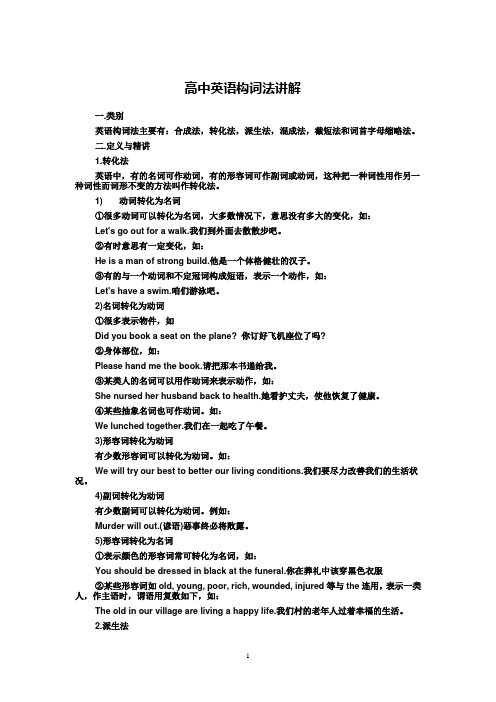
高中英语构词法讲解一.类别英语构词法主要有:合成法,转化法,派生法,混成法,截短法和词首字母缩略法。
二.定义与精讲1.转化法英语中,有的名词可作动词,有的形容词可作副词或动词,这种把一种词性用作另一种词性而词形不变的方法叫作转化法。
1) 动词转化为名词①很多动词可以转化为名词,大多数情况下,意思没有多大的变化,如:Let's go out for a walk.我们到外面去散散步吧。
②有时意思有一定变化,如:He is a man of strong build.他是一个体格健壮的汉子。
③有的与一个动词和不定冠词构成短语,表示一个动作,如:Let's have a swim.咱们游泳吧。
2)名词转化为动词①很多表示物件,如Did you book a seat on the plane? 你订好飞机座位了吗?②身体部位,如:Please hand me the book.请把那本书递给我。
③某类人的名词可以用作动词来表示动作,如:She nursed her husband back to health.她看护丈夫,使他恢复了健康。
④某些抽象名词也可作动词。
如:We lunched together.我们在一起吃了午餐。
3)形容词转化为动词有少数形容词可以转化为动词。
如:We will try our best to better our living conditions.我们要尽力改善我们的生活状况。
4)副词转化为动词有少数副词可以转化为动词。
例如:Murder will out.(谚语)恶事终必将败露。
5)形容词转化为名词①表示颜色的形容词常可转化为名词,如:You should be dressed in black at the funeral.你在葬礼中该穿黑色衣服②某些形容词如old, young, poor, rich, wounded, injured等与the连用,表示一类人,作主语时,谓语用复数如下,如:The old in our village are living a happy life.我们村的老年人过着幸福的生活。
初中英语语法之构词法知识讲解

英语构词法知识讲解一总体原则:1. 关于双写:任何双写单词都有一个共同规律:所谓“以一个辅音字母结尾的重读闭音节”指的是:必须是一个单音节词(单音节全部重读),最后两个字母必须是一个元音字母加一个辅音字母,而且不可以合起来发音,如few, new, show, row 不双写因为ow 合起来发音,follow, visit 不双写因其两个音节,重读第一音节。
Begin 双写因其重读第二音节,例run—running, win—winner, sun—sunny, drop—dropped, hot-hotter--hottest2. 关于变y 为i:任何变y 为i 加后缀的也有一个共同的要求------以辅音字母加y 结尾。
例:busy-business beauty-beautiful city-cities early-earlier history-historical lucky—luckily mystery—mysterious study—studies twenty--twentieth关于去e:如果所加词缀是以元音字母开头,则去e,例:以 a 开头nature—natural believe--believable以 e 开头nice--nicer write—writer use--used以i/y 开头(y 是半元音)noise—noisy live—living create—creative—creativity educate—education以o 开头fame—famous translate—translator以u 开头please—pleasure如果所加词缀不以元音字母开头,则不去e,例love--lovely move—movement peace--peaceful home—homeless特殊nine--ninth true--truth关于变 f 为v 加es,其实ve 也可以变成f:twelve—twelfth myself—ourselves knife—knives believe—belief二、名词变复数规则:1)直接加s ;2)加es(以s ,x,ch,sh,o 结尾的单词);3)变y 为i 加es(辅音字母+y);4)变f/fe 为ves;5)不规则变化;man—men 男人woman—women 女人child—children 孩子tooth—teeth 牙齿foot—feet 脚mouse—mice 老鼠三、动词变第三人称单数规则:1)直接加s(have—has);2)加es(以s ,x,ch,sh,o 结尾的单词);3)变y 为i 加es(辅音字母+y);4)不规则变化have--has; be—am is are;四、动词变现在分词规则:1)直接加ing;2)去e 加ing(以e 结尾的单词),但lie-lying 躺die-dying 死亡tie-tying 系see-seeing看见be-being 除外;3)双写加ing(以一个辅音字母结尾的重读闭音节)注意:双写加ing 的动词(25 个)get 得到set 安排let 让sit 坐hit 撞fit 适合dig 挖win 赢kid 开玩笑run 跑cut 切put 放hug 拥抱chat 聊天plan 计划shop 购物drop 扔chop 砍stop 停shut 关swim 游泳begin 开始forget 忘记prefer 更喜欢regret 遗憾五、基数词变序数词规则:1)直接加th;2)去e 加th(nine--ninth);3)变y 为i 加eth(辅音字母+y,整十单词都带ty);4)变ve 为f 加th(如five—fifth, twelve—teelfth);附:first second third六、代词变反身代词:1)单数加self,复数加selves(变f 为v 加es),2)第一二人称在形容词物主代词的基础上加self\selves,第三人称在人称代词的宾格的基础上加self\selves七、形容词变比较级、最高级规则:1)直接加er/est;2)去e 加er/est(以e 结尾的单词)3)变y 为i 加ed(辅音字母+y);4)双写加(以一个辅音字母结尾的重读闭音节)注意:双写加er/est 的单词有:red big hot wet thin fat sad5)不规则变化好good/well--更好better--最好--best坏bad/badly--更坏worse--最坏worst许多many/much--更多more--最多most一点little--较少less--最少least远far--较远farther/further (意义深远)--最远farthest/furthest老的,旧的old--较老的,较旧的older/elder(大哥)--最老的,最旧的oldest/eldest八、动词变过去式规则:1)直接加ed2)去e 加ed(以e 结尾的单词)3)变y 为i 加ed(辅音字母+y);4)双写加ed(以一个辅音字母结尾的重读闭音节)注意:双写加ed 的动词:hug拥抱nod点头chat聊天shop购物drop丢弃chop砍stop停plan 计划prefer更喜欢regret 遗憾九、词性的转变1.动词(v.)→名词(n.)(a)词形不变,词性改变例如:work, study, water, plant 等可以用作动词(工作,学习,浇水,种植),也可以用作名词(工作, 学习,水,植物).(b)一些动词在词尾加上-er 或-or 之后就变成了表示"某一类人"的名词例如:work—worker, teach—teacher, sing—singer,jump—jumper, play—player, learn—learner,visit—visitor, invent—inventor,collect—collector 等.注意:1)以不发音的 e 结尾的动词,在词尾加-r.例如:drive—driver, write—writer 等.2)以重读闭音节结尾,且末尾只有一个辅音字母的动词,应双写末尾的辅音字母,再加-er例如:run—runner, win—winner,begin—beginner 等.(c)在动词词尾加上-ment 变成名词例如:achieve—achievement (成就) advertise—advertisement//advertising(广告) agree—agreement disgree—disagreementamuse—amusement (娱乐) improve—improvement(争吵)commit(奉献)—commitment develop—development (发展)depart—department (局,部) govern(统治)—government(政府)manage—management (管理) equip—equipment (装备)有些单词比较特殊,需把动词后的 e 去掉再加ment. 例如:argue—argument(争论)(d)在动词词尾加上-(t)ion/(s)ion 变成名词例如: attract—attraction; instruct—instruction; invent—inventiondiscuss—discussion; express—expressioneducate—education; graduate—graduation; operate—operation (去e 再加"ion") compete—competition; organize—organization (把e 改成其他字母再加"tion") decide—decision; conclude—conclusion (把de 改为s 再加"ion") describe—description ᧿写,᧿绘(这是特例,不规则变化)(e)在动词词尾加上-ance 变成名词例如: appear—appearance (外貌;出现)perform—performance (演出)accept—acceptance (接受)(f)在动词词尾加-ing 变成名词(方法与动词变为现在分词的方法相同)例如:meet—meeting build—building wait—waitingbathe—bathing say—saying(谚语) mean—meaningend—ending train —training wash—washing注意:以重读闭音节结尾,且末尾只有一个辅音字母的动词,应双写末尾的辅音字母,再加-ing 如:swim—swimming shop—shopping begin—beginning(g)其他一些比较特殊的变化例如: Beg(乞讨)—beggar(乞丐) behave(行为举止)—behaviorknow(知道)—knowledge(知识) fly—flight (飞行)heat (加热)—heat(热量) hit (撞击)—hit( 轰动一时的人或物,碰撞)mix (混合)—mixture(混合物) press(按,压)—pressure(压力)sit(坐)—seat (座位) succeed—success(成功)tour—tour(旅游)/ tourist (游客)2.动词(v.)→形容词(adj.)(a)动词后面加able,以e 结尾的动词则去e 加able,表示具有此性质,特点或属性.例如: afford-affordable; love-lovable(b)动词后面加ed,以e 结尾的动词则直接加d,表示被动性的属性或特点.例如: scatter-scattered; use-used(c)不规则的动词则必须记忆,记住其过去分词形式.规律不大,意义同(b).3.名词(n.)→形容词(adj.)(a)在名词后面加-y 可以变成形容词(尤其是一些与天气有关的名词)例如: rain—rainy, cloud—cloudy, wind—windy, snow—snowy,health—healthy, luck—lucky,anger—angry guilt—guilty(内疚的)tourist—touristy(游客多的) , salt (盐)—salty (咸的)silk(丝绸)—silky(丝绸般的), sleep—sleepy (昏昏欲睡的)注意:1)如果以重读闭音节结尾,且词尾只有一个辅音字母,这时应双写辅音字母再加"-y". 如: sun—sunny, fun—funny, fog—foggy(有雾的), fur—furry(毛皮的)2)少数以不发音的e 结尾的名词变为形容词时,应去掉e 再加"-y".如: noise—noisy, ice—icy, shine—shiny(发亮的), taste(口味)—tasty(甜的)(b)名词后面加-ed,以e 结尾的直接加d.例如: spot(斑点)—spotted(有斑点的); talent—talented (有天赋的) organize—organized 有组织的; balance—balanced(平衡的)(c)一些抽象名词在词尾加-ful 可以变为形容词例如:care—careful, thank—thankful, help—helpful,use—useful, meaning—meaningful(d)在名词后加-less 构成含有否定意义的形容词例如:care—careless(粗心的), use—useless(无用的)hope—hopeless(没希望的),home—homeless(无家可归的)(e)一些以-ce 结尾的名词,把-ce 改为-t 变成形容词例如: difference—different, silence—silent, confidence—confident(f).在名词后加-ly 变为形容词例如: friend—friendly, love—lovely, live---lively(g).在名词后加-ous 变为形容词例如: danger—dangerous(h)名词后面加-al 变为形容词例如: music—musical; medicine—medical (这个比较特殊)(i)名词后面加-able 变为形容词,如果以e 结尾就去e 再加"-able".例如: adjust—adjustable 可调整的value—valuable 有价值的(j)名词后面加-en 变成形容词例如: wood—wooden 木制的wool—woolen 羊毛的(k)一些表示国家的名词可以在词尾加-ese, -ish 或-n 构成表示国籍,语言的形容词例如:China—Chinese, Japan—Japanese, England—English,America—American, India—Indian, Australia —Australian (注意Canada—Canadian) 4..形容词(adj.)→副词(adv.)▲一般在形容词的词尾加-ly 可以变成副词例如: quick—quickly, slow—slowly, loud—loudly, sudden—suddenly 等但是,以下几点值得注意:(a) 一些以"辅音字母+y"结尾的形容词,要把y 改为i 再加-ly例如: happy—happily, angry—angrily, lucky—luckily, heavy—heavily, noisy—noisily (b) 有些以-ble 或-le 结尾的形容词,去掉e 加-y例如:possible—possibly, terrible—terribly(c)少数以e 结尾的形容词,要去掉e 再加-ly例如: true—truly但绝大多数以 e 结尾的形容词仍然直接加-ly 例如: polite—politely, wide—widely(d)以-l 结尾的形容词变为副词时要在词尾加-ly,以-ll 结尾的才在词尾只加-y.例如: usual—usually, careful—carefully, useful—usefully full—fully (以-ll 结尾的才只加y)。
英语基础知识 构词法的讲解与训练

英语基础知识构词法的讲解与训练构词法英语构词方法主要有三种:即合成法(compounding)、派生法(derivation )和转化法(conversion)。
1. 合成法:将两个或两个以上的单词合成在一起而构成的新词,叫做合成词。
如:snow-white 雪白的;day-long 整天的;overcome 克服;downstairs 在楼下2. 派生法:所谓派生,即在词根上加前缀或后缀构成另一个与原意略有变化或截然相反的词。
例:discover 发现;disagree 不同意的;nation→national 民族的,国家的;nature→natural 自然的;treatment 治疗;development 开发展3. 转化法:英语单词的词性非常活跃,名词用作动词,动词转化为名词,形容词用作动词等现象非常普遍,这种把一种词性用作另一种词性的方式就叫做词性的转化。
如:(1)有大量动词可以转化为名词,有时意思没变化。
Let me have a try. 让我试一试。
(2)名词转化为动词。
Have you booked your ticket? 你的票订好了吗?(3)一些表示某类人的名词也可做动词。
If so,we shall be badly fooled. 如果这样我们就会上大当。
(4)形容词转化为动词。
The train slowed down to half its speed. 火车速度减慢了一半。
1、合成法(1)合成形容词①名词+现在分词例:English-speaking 讲英语的,south-facing 朝南的②名词+过去分词例:man-made 人造的,water-covered 被水覆盖的③名词+形容词例:snow-white 雪白的,day-long 整天的④形容词+名词+-ed 例:warm-hearted 热情的,kind-hearted 好心肠的⑤形容词/副词+现在分词例:good-looking 好看的,funny-looking 滑稽的⑥副词+过去分词例:well-known 出名的, deep-set(眼睛)深陷的⑦副词/形容词+名词例:right-hand 右手的,full-time 专职的⑧数词+名词例:100-meter 100米的,million-pound 百万英镑的⑨数词+名词+形容词例:180-foot-high 180英寸高的,10-year-old 10岁的⑩数词+名词+-ed 例:four-footed/legged 四脚的,one-eyed 独眼龙的(2)合成名词①名词+名词例:weekend 周末,classroom 教室,bookshop 书店②形容词/介词+名词例:gentleman 绅士,loudspeaker 扬声器③动词+名词例:typewriter 打字机,cookbook 烹调书④名词+动词例:daybreak 破晓,toothpick 牙签⑤动词-ing形式+名词例:reading-room 阅览室,sleeping-car 卧车车厢⑥副词+动词例:outbreak 爆发,downpour 倾盆大雨⑦名词+动名词例:handwriting 笔迹,sun-bathing 日光浴⑧名词+in/to+名词例:mother-in-law 岳母,brother-in-law 姐夫(3)合成动词①副词+动词例:overthrow 推翻,understand 理解②形容词+动词例:broadcast 广播,whitewash 粉刷③名词+动词例:typewrite 打字,sleepwalk 梦游(4)合成副词①介词+名词例:underfoot 脚下,beforehand 事先②形容词+名词例:hotfoot 匆忙地,someday 有朝一日③形容词+副词例:anywhere 任何地方,outwards 向外、(5)合成介词:within在……之内,without没有,inside在……里边,into进入(6)合成代词:myself我自己,ourselves我们自己,anyone任何人,nobody没有人nothing 没东西,somebody有人。
初中英语语法之构词法讲解

形容词+动词-ing形式:good-looking相貌好看的easy-going脾气随和的
副词+动词-ing形式:hard-working students勤劳的far-reaching深远的long-lasting耐用的
副词+形容词:ever-green trees常青树
形容词+形容词:light-blue浅蓝色的
动词+副词:see-through pool透明的
介词+名词:downhill下坡的uphill上山的
(3)合成动词
副词+动词:ill-treat虐待undergo经历overhear(无意)听见overthrow推翻
inter-(相互;之间):international, interrelation
en-(使可能):encourage, enablear, disagree, discourage, disappoint, dishonest,
in-/il-/im-/ir-(不;非):invisible(看不见的),illogical, illegal(非法的), impolite, impossible, irregular, irresponsible
un-/non-(不;非):unfit, unfair, unknown, non-conductor(非导体)
He visited the summer palace yesterday. 他昨天参观了颐和园。(动词)
we paid a visit to the scientist last week. 我们上星期拜拜访了那位科学家。(名词)
He likes a quiet smoke after supper. 他喜欢在晚饭后静静地抽了一会儿烟。(名词)
史上最全的构词法用法详解

史上最全的构词法用法详解史上最全的构词法用法详解构词法语言中词的总和构成词汇,但是词汇并不是一堆杂乱无章、互不相关的群体,而是一个严密体系,在这个结构的体系中,词与词之间有着各种各样的联系。
英语中的这些联系的规律总结起来就是构词。
英语中构词的方法就是构词法。
构词法主要有合成法、转化法、派生法和缩略法四种。
掌握构词法是迅速扩大词汇量的重要方法之一。
第一节合成法合成法就是指由两个或两个以上的单词合成的词叫合成词。
这种构词方式主要有两种:复合法、结合法。
合成法主要是构成合成名词和合成形容词。
复合法构成的复合词,它们各个结合的部分相互间的语法关系是紧密相关的。
如blackboard和darkroom都是形容词和名词形成的结构,writing desk是动词名词和名词形式的结构。
结合法形成的词是形态合成词,它的结合是用一个起来连接作用的中缀来把两个或两上以上的词根词素紧紧的连缀在一起。
如,用辅音字母-s-来缀全两个词根词素构成的词有:salesman, townspeople等。
合成的方式常见的有如下几种:一、合成名词1、名词/代词+名词:woman-doctor, women-doctors, workshop, spaceship, he-goat, coal fire, motorcycle, gas cooker, oil well, power plant, silk worm, gold mine, bottleneck, piano keys, telephone receiver, television screen, chairman, fireman, motorman, police-officer, postman, pine tree, girl friend, boy friend, goldfish, raindrop, birdcage, breakfast time, flowerbed, tearoom,2、动词+名词:blowpipe, flashlight, watchdog, call-girl, searchlight3、形容词+名词:blacksmith, blackboard, supermarket, superman, darkroom, blackbird, highchair, hothouse, greenhouse, madman4、动名词+名词:reading-room, sitting-room, classroom, schoolroom, dining room, building materials, dancing girl, cleaning women, flying machine, washing machine, working conditions, boilding point, drinking water, swimming pool, drinking cup, typing paper, writing desk, sewing machine, walking stick,5、名词+动名词:machine-building, shoe-making, paper-correcting, book-keeping, dressmaking, letter-writing, story-telling, town-planning, handwriting, sun-bathing, horse riding, churchgoing, daydreaming6、动词+副词:stand-by, take-off, cut-off, breakdown7、副词+名词:downfall, rainfall, outhouse8、现在分词+名词:running dog, running water, flying fish, rising sun, burning stick,9、名词+介词+名词:man-of-war, editor-in-chief,10、名词+连词字母+名词:handiwork, nowadays11、介词/副词+名词:afternoon, inland, overbalance二、合成形容词1、形容词+名词+ed:five-storeyed, one-eyed, double-faced, blue-eyed,2、名词+名词+ed:honey-mouthed,3、名词/代词+分词:man-made, heart-broken, self-educated, snow-covered, man-eating, peace-loving, paper-making, ocean-going, heartfelt, handmade, home-made, sunburnt, weather-beaten4、名词/代词+形容词:color-blind, ice-cool, seasick, airsick, tax-free, grass-green, snow-white, rock-hard, sea-green5、形容词/数词+名词:full-time, high-grade, second-hand,6、形容词/数词+分词:ready-made, sleepy-looking, good-looking,7、副词+分词:far-reaching, so-called, hard-working, far-reaching, well-meaning, newly-laid, well-meant, wide-spread8、副词+形容词:ever-green, under-ripe,9、形容词+形容词:dark-blue, red-hot, grey-green10、介词+名词:downhill, overnight三、合成副词1、形容词+名词:sometimes, meanwhile2、副词+名词:oftentimes, indoors, outdoors, overhead3、介词+名词:alongside, beforehand4、名词+形容词:skyhigh, stonestill,5、副词+介词:nearby, upalong,四、合成动词1、名词+动词:overhear, underline2、形容词+动词:moonwalk3、副词+动词:white-wash, safeguard五、其它合成词1、合成代词:everybody, everyone, everything, anyone, anybody, anything2、合成介词:outside, inside, throughout第二节转化法不用借助构词词缀,把一个单词从一种词类转化成另一种词类的方法就是转化法。
英语构词法讲解

sweetheart情人,爱人
3、动词+名词 n.
例:pickpocket扒手 breakwater防波堤
cut-throat凶手
4、副词+名词 n.
例:overcoat大衣 眺望
upside上边
outlook远景,
5、名词+动名词 n. 例: watch-making制表业
machine-building机制业
22、trans-转移,变化,横过
例:transform转化
translate翻译
transport运输
23、un-不,非,无 义
加在动词、形容词前表示相反的意
例:unhappy不高兴 undress脱衣服 unhealthy不健康的
24、under-在下,低下 例:underground地下,地铁 underwater水下的 underline在。。。下划线
world-wide世界规模的
9、名词+名词+ed adj. 例:iron-willed有钢铁意志的 chicken-hearted胆小的
kilowatt 千瓦
10、mid-中 例:midnight午夜 midway中途
mid-autumn 中秋
11、mis-误,错 例:mistake 错误
misread 读错
misunderstand 误会,误解
12、inter-之间,在内,相互 例:internal 内部的 international 国际的 interchangeable 可互换的 interaction互动
wooden木制的
woolen毛织
35、-ward adj.&adv. 向… 例:forward向前(的 )upward向上(的)backward向后(的)
(完整版)英语构词法详解及练习
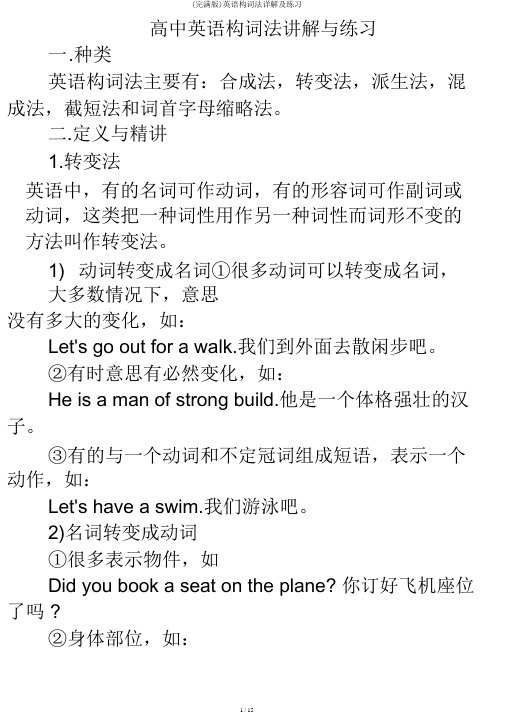
高中英语构词法讲解与练习一.种类英语构词法主要有:合成法,转变法,派生法,混成法,截短法和词首字母缩略法。
二.定义与精讲1.转变法英语中,有的名词可作动词,有的形容词可作副词或动词,这类把一种词性用作另一种词性而词形不变的方法叫作转变法。
1)动词转变成名词①很多动词可以转变成名词,大多数情况下,意思没有多大的变化,如:Let's go out for a walk.我们到外面去散闲步吧。
②有时意思有必然变化,如:He is a man of strong build.他是一个体格强壮的汉子。
③有的与一个动词和不定冠词组成短语,表示一个动作,如:Let's have a swim.我们游泳吧。
2)名词转变成动词①很多表示物件,如Did you book a seat on the plane? 你订好飞机座位了吗 ?②身体部位,如:Please hand me the book请.把那本书递给我。
③某类人的名词可以用作动词来表示动作,如:Shenursed her husband back to health她.看护丈夫,使他恢复了健康。
④某些抽象名词也可作动词。
如:We lunched together我.们在一起吃了午餐。
3)形容词转变成动词有少许形容词可以转变成动词。
如:We will try our best to better our living conditions.我们要全力改进我们的生活情况。
4)副词转变成动词有少许副词可以转变成动词。
比方:Murder will out.( 谚语 )恶事终必然败事。
5)形容词转变成名词①表示颜色的形容词常可转变成名词,如:You should be dressed in black at the funeral.你在葬礼中该穿黑色衣服②某些形容词如 old, young, poor, rich, wounded, injured 等与 the 连用,表示一类人,作主语时,谓语用复数以下,如:The old in our village are living a happy life. 我们村的老年人过着幸福的生活。
第07讲 构词法(讲义)-2025年高考英语一轮复习讲练测(新教材新高考)含解析
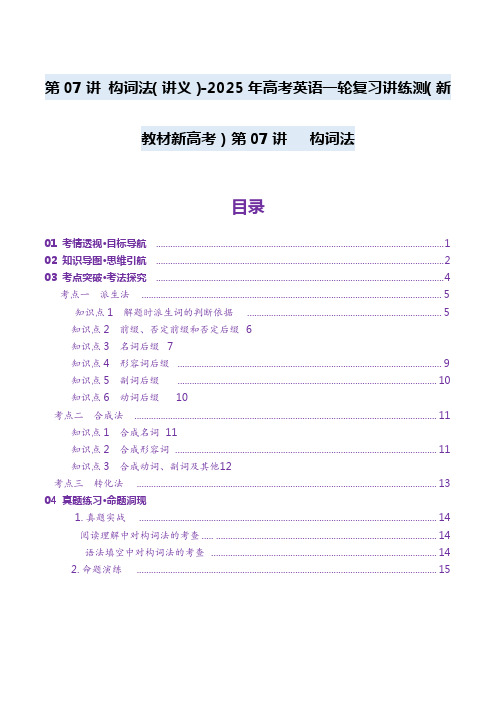
第07讲构词法(讲义)-2025年高考英语一轮复习讲练测(新教材新高考)第07讲构词法目录01 考情透视.目标导航 (1)02 知识导图.思维引航 (2)03 考点突破.考法探究 (4)考点一派生法 (5)知识点1 解题时派生词的判断依据 (5)知识点2 前缀、否定前缀和否定后缀 6知识点3 名词后缀 7知识点4 形容词后缀 (9)知识点5 副词后缀 (10)知识点6 动词后缀10考点二合成法 (11)知识点1 合成名词11知识点2 合成形容词 (11)知识点3 合成动词、副词及其他12考点三转化法 (13)04 真题练习·命题洞现1.真题实战 (14)阅读理解中对构词法的考查..... .. (14)语法填空中对构词法的考查 (14)2.命题演练 (15)复习目标:、具备根据语境推断词性及意思的能力;掌握构词法的三大规则:派生、合成和转换;掌握构词法,提高阅读速度,提高核心素养;具备根据句法知识判断句子成分并判断其词性,然后准确写出正确形式的能力;考点概述:许多英语单词的构词都有一定的规律,这种规律被成为构词法。
掌握构词法知识对考生更好的理解词义、认识新词和扩大词汇量有重要意义。
意义中的构词法主要有派生法(Derivation)、合成法(Composition)和转换法(Conversion)三大类。
【高考导航】1.(2024年浙江1月高考阅读理解D片段)We are tempted by sugary treats because our ancestors lived in a calorie-poor world, and our brains developed a response mechanism to these treats that reflected their value— a feeling of reward and satisfaction.2. (2023年新高考I卷) Xiao long bao(soup dumplings), those amazing constructions of delicate dumpling wrappers, encasing hot, ___56___(taste)soup and sweet, fresh meat, are far and away my favorite Chinese street food.考点一派生法知识点1 派生词的判断依据1.冠词、物主代词等词类后一般跟名词。
英语构词法

ation
●注意:compete /apply/ solve /intend compete----competition apply----application solve----solution intend---intention
4、表示共同、相等关系 (1) com-(在b, m, p前),col-,con-,
cor-(com在g, l, r及其它辅音前):
company, cnnect, correct (2) co-:cooperate, coexist (3) sym-:sympathy, symphony
5、表示整个、完全关系 (1) al-:alone, almost, altogether (2) over-:overall, overflow, overfall
c. un+动词:uncover, untie, unlock, undress, undo, unpack
(2) im+形容词:impossible, impolite (3) in+形容词:incorrect, incomplete, invisible, independent
(4) ir+形容词:irregular (5) mis+动词:misspell, misunderstand, mistake
3、表示时间、序列关系的前缀 (1) fore-,表示“在前,预先”:foreword, foresight, foretell (2) mid-,表示“中间”:midnight, midsummer, midautumn (3) post-,表示“在……后”:postwar, postlistening (4) re-,表示“重复”:review, retell, rewrite, replace, return, rebuild (5) extra-,表示“格外、超越”:extraordinary (6) over-,表示“超过”: overcome, overeat, overpass (7) super-,表示“极、超”:supermarket, superpower, superman, superpower
英语构词法1
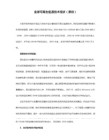
Testing of English as a Foreign Language→TOEFL托福
(二)[基础过关]
1. There were ________fish in the river in South America.
A. in danger B. danger
A. lead B. leader C. leading D. leadership
答案:C
解析:空白处为定语修饰railway engineer,需用形容词。故选C。
7.When the teacher praised him for working out the maths problem,Jack looked ________about at his classmates.
A. judger B. judgment
A. satisfied B. satisfactory
C. satisfying D. satisfaction
答案:D
解析:空白在所有格后,应为名词,故选D。
9. No one should enter the spot without the________of the police.
派生法是在一个词根的前面或后面加上某个词缀来产生新词。加在前面的叫前缀,加在后面的词缀叫做后缀。
前缀多引起词义的变化而不改变词性。后缀对词性、词义都可能有影响。
例如: dis agree ment (不同意 n .)
6、首尾字母缩略法
首尾字母缩略法,即用单词首尾字母组成一个新词。读音主要有两种形式,即各字母分别读音;作为一个单词读音。
very important person→VIP (读字母音)要人;大人物
(2021年整理)英语构词法讲解及专项练习

英语构词法讲解及专项练习编辑整理:尊敬的读者朋友们:这里是精品文档编辑中心,本文档内容是由我和我的同事精心编辑整理后发布的,发布之前我们对文中内容进行仔细校对,但是难免会有疏漏的地方,但是任然希望(英语构词法讲解及专项练习)的内容能够给您的工作和学习带来便利。
同时也真诚的希望收到您的建议和反馈,这将是我们进步的源泉,前进的动力。
本文可编辑可修改,如果觉得对您有帮助请收藏以便随时查阅,最后祝您生活愉快业绩进步,以下为英语构词法讲解及专项练习的全部内容。
构词法Word Formation在英语中,词的构成方式主要有三种:合成、转化和派生。
一、合成 Compounding 两个或更多的词合成一个词。
方式:1. 直接写在一起. 2。
用连字符(—)连接。
3. 由两个分开的词构成.(1) 合成形容词(2)合成动词(3)合成名词(4)合成副词however, maybe, wherever, whenever, forever(5)合成代词whoever,, whatever, everyone, nobody, myself, something,anything,二、派生 Derivation 前缀后缀注意: -ese, —ian, —ist 既可以构成名词,又可以构成形容词.-er 构成的名词,既有表示人的,又有表示物的。
三、转化 Conversion:指一个词不变化词形,而由一种此类转化为另一种词类或几种词类。
1。
名词和动词之间的转化telephone电话——打电话, mirror镜子——像镜子一样反映, drink喝--饮料,record录音——记录, name, date, hand, study,2. 形容词转化为动词 perfect完美的-—使完善3.名词转化为形容词(副词) front前面——前面的4.形容词转化为名词 chief 主要的-—首领语法填空之构词法专项练习1。
The soldier died for saving the child,so his________(die) is heavier than Mount Tai.2. The Great Wall is more than 6000 li in ________(long).3. How________ (fool) he is!4。
英语构词法详细讲解
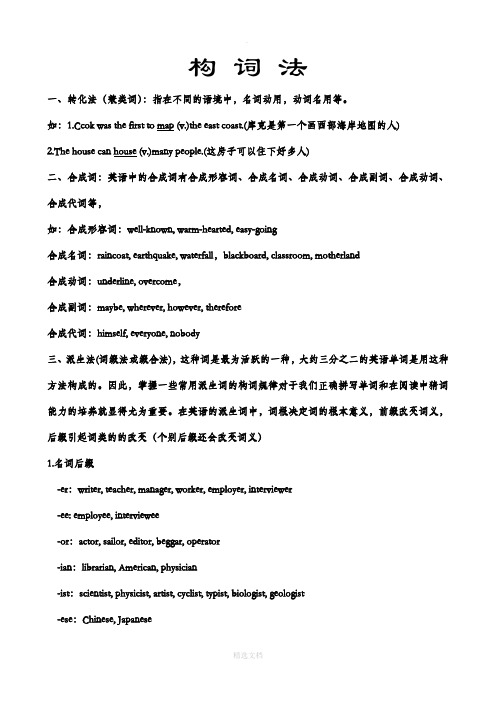
构词法一、转化法(兼类词):指在不同的语境中,名词动用,动词名用等。
如:ok was the first to map (v.)the east coast.(库克是第一个画西部海岸地图的人)2.The house can house (v.)many people.(这房子可以住下好多人)二、合成词:英语中的合成词有合成形容词、合成名词、合成动词、合成副词、合成动词、合成代词等,如:合成形容词:well-known, warm-hearted, easy-going合成名词:raincoat, earthquake, waterfall,blackboard, classroom, motherland合成动词:underline, overcome,合成副词:maybe, wherever, however, therefore合成代词:himself, everyone, nobody三、派生法(词缀法或缀合法),这种词是最为活跃的一种,大约三分之二的英语单词是用这种方法构成的。
因此,掌握一些常用派生词的构词规律对于我们正确拼写单词和在阅读中猜词能力的培养就显得尤为重要。
在英语的派生词中,词根决定词的根本意义,前缀改变词义,后缀引起词类的的改变(个别后缀还会改变词义)1.名词后缀-er:writer, teacher, manager, worker, employer, interviewer-ee: employee, interviewee-or:actor, sailor, editor, beggar, operator-ian:librarian, American, physician-ist:scientist, physicist, artist, cyclist, typist, biologist, geologist-ese:Chinese, Japanese(-er, -ee,-or, -ian, -ist, -ese: 表示“从事某种职业或来自------的人” )-ism:Marxism, socialism, nationalism, communism (-ism表示----主义)-ess:actress, waitress, hostess (-ess表示性别)-ness:happiness, illness, coldness, carelessness, sickness-ment:movement, agreement, achievement, appointment, adjustment-ship:friendship, hardship(困苦、苦难、艰难困苦)-ion:education, decision, communication, impression, description, collection-ity:reality, purity, responsibility, possibility-ance(ence):performance, independence, science , violence, reference, appearance-ure:failure, departure(分离,分开)-al:arrival,survival, signal-hood:childhood, boyhood, neighborhood, livelihood-th: truth, depth,(-ism, -ess, -ness, -ment, -ship, -ion, -ity, -ance(ence), -ure, -al, -hood, -th: 表示“行为的过程、状态或性质”)2.形容词后缀-less: hopeless, endless, careless, helpless, (表“否定”)-ful: useful, careful, hopeful, grateful, powerful-ous:dangerous, humorous, cautious, infectious-able:enjoyable, comfortable, considerable, admirable, unforgettable-y:snowy, dirty, greedy, rainy, sunny, guilty-ent(-ant):different, independent, confident, violent, efficient, distant-tic: optimistic, pessimistic, enthusiastic, characteristic-ary: necessary, revolutionary, imaginary-(c)al: historical, unusual, professional, magical, physical, universal, classical, logical, informal -some:handsome,troublesome-en:woolen, golden,-an:African, American-ive:active, attractive, creative(-ful, -ous, -able, -y, -ent, -some, -en, -an, -ive :表示“属性、倾向、相像”)3.副词后缀-ly:really, nearly, differently, finally, fluently, gradually-wise: (表示“方向、样子、状态、在------方面”)likewise, otherwise-ward(s): upward, downward, inward, outward, backward, forward, afterwards4.动词后缀-ize(-ise): organize, apologize, specialize-en:harden, fasten(使固定、使牢固), soften-fy: beautify, simplify, classify-ate: separate, operate(-ize(-ise), -en, -fy, -ate: 表示“使成为、处理、作用”)5.反义词前缀un-: unfair, unknown, unlike, unwilling, unfit, unnecessary, unlikely, unkinddis-: dislike, disappear, disadvantageim-: impossible, immoral, impatient, impractical, improperin-: incorrect, inappropriate, informalnon-: nonsmoker, nonsense,non -drinker(un-, dis-, im-, in-, non-: 表示“无、不、非”)mis-: mistake, mislead, misunderstandmal-:malfunction(发生故障;不起作用)(mis-, mal: 表示“反动作”)6.其他表示空间、位置、方向、关系、程度的前缀(1) a- , up-, over-, sur-, super- : 表示“在------之上”aboard, uphill, overlook, surface, supermarket, superstar(2)extra-, ex-, out- :表示“在-----之外”:extraordinary, export, outside, outdoors(3)under-, sub-, vice- :表示“在----之下”:underground, subway, vice-president(4)inter-: 表示“两者间”:internet, international, interpersonal(5)co-, con-, col-, com-: 表示“相同、相等合作”coexist(共存,和平共处), connect, collect, combine(6)trans-:表示“移动” translate, transform, transmit(传输信号等),transfer(转让、转移)(7)anti-反,抗,阻:anti-black, antibody, anti-depressant(抗抑郁的)(8)re-再,又:rebuild, rewrite, retell(9)micro-microbiology, microcomputer, microscope, microwave(微波)(10)tele-:远距离的,远的:telephone, television, telescope, teleprinter(电传打印机)四、缩略词缩略:为了称说方便,使事物称谓中的成分进行有规律的节缩或者省略叫做缩略。
史上最全的构词法用法详解

史上最全的构词法用法详解史上最全的构词法用法详解构词法语言中词的总和构成词汇,但是词汇并不是一堆杂乱无章、互不相关的群体,而是一个严密体系,在这个结构的体系中,词与词之间有着各种各样的联系。
英语中的这些联系的规律总结起来就是构词。
英语中构词的方法就是构词法。
构词法主要有合成法、转化法、派生法和缩略法四种。
掌握构词法是迅速扩大词汇量的重要方法之一。
第一节合成法合成法就是指由两个或两个以上的单词合成的词叫合成词。
这种构词方式主要有两种:复合法、结合法。
合成法主要是构成合成名词和合成形容词。
复合法构成的复合词,它们各个结合的部分相互间的语法关系是紧密相关的。
如blackboard和darkroom都是形容词和名词形成的结构,writing desk是动词名词和名词形式的结构。
结合法形成的词是形态合成词,它的结合是用一个起来连接作用的中缀来把两个或两上以上的词根词素紧紧的连缀在一起。
如,用辅音字母-s-来缀全两个词根词素构成的词有:salesman, townspeople等。
合成的方式常见的有如下几种:一、合成名词1、名词/代词+名词:woman-doctor, women-doctors, workshop, spaceship, he-goat, coal fire, motorcycle, gas cooker, oil well, power plant, silk worm, gold mine, bottleneck, piano keys, telephone receiver, television screen, chairman, fireman, motorman, police-officer, postman, pine tree, girl friend, boy friend, goldfish, raindrop, birdcage, breakfast time, flowerbed, tearoom,2、动词+名词:blowpipe, flashlight, watchdog, call-girl, searchlight3、形容词+名词:blacksmith, blackboard, supermarket, superman, darkroom, blackbird, highchair, hothouse, greenhouse, madman4、动名词+名词:reading-room, sitting-room, classroom, schoolroom, dining room, building materials, dancing girl, cleaning women, flying machine, washing machine, working conditions, boilding point, drinking water, swimming pool, drinking cup, typing paper, writing desk, sewing machine, walking stick,5、名词+动名词:machine-building, shoe-making, paper-correcting, book-keeping, dressmaking, letter-writing, story-telling, town-planning, handwriting, sun-bathing, horse riding, churchgoing, daydreaming6、动词+副词:stand-by, take-off, cut-off, breakdown7、副词+名词:downfall, rainfall, outhouse8、现在分词+名词:running dog, running water, flying fish, rising sun, burning stick,9、名词+介词+名词:man-of-war, editor-in-chief,10、名词+连词字母+名词:handiwork, nowadays11、介词/副词+名词:afternoon, inland, overbalance二、合成形容词1、形容词+名词+ed:five-storeyed, one-eyed, double-faced, blue-eyed,2、名词+名词+ed:honey-mouthed,3、名词/代词+分词:man-made, heart-broken, self-educated, snow-covered, man-eating, peace-loving, paper-making, ocean-going, heartfelt, handmade, home-made, sunburnt, weather-beaten4、名词/代词+形容词:color-blind, ice-cool, seasick, airsick, tax-free, grass-green, snow-white, rock-hard, sea-green5、形容词/数词+名词:full-time, high-grade, second-hand,6、形容词/数词+分词:ready-made, sleepy-looking, good-looking,7、副词+分词:far-reaching, so-called, hard-working, far-reaching, well-meaning, newly-laid, well-meant, wide-spread8、副词+形容词:ever-green, under-ripe,9、形容词+形容词:dark-blue, red-hot, grey-green10、介词+名词:downhill, overnight三、合成副词1、形容词+名词:sometimes, meanwhile2、副词+名词:oftentimes, indoors, outdoors, overhead3、介词+名词:alongside, beforehand4、名词+形容词:skyhigh, stonestill,5、副词+介词:nearby, upalong,四、合成动词1、名词+动词:overhear, underline2、形容词+动词:moonwalk3、副词+动词:white-wash, safeguard五、其它合成词1、合成代词:everybody, everyone, everything, anyone, anybody, anything2、合成介词:outside, inside, throughout第二节转化法不用借助构词词缀,把一个单词从一种词类转化成另一种词类的方法就是转化法。
2025中职高考英语复习构词法考点精析精练

B. disappointed
C. disappointing
D. disappointment
【答】此处表示“令人失望的”,应用 disappointing。 故选C。
随后练1
6. The soldier died for saving the child, so his D is heavier than Taishan Mountain.
考点三 转化法
1. 名词和动词之间的转化
例如:
telephone 电话——打电话
mirror 镜子——像镜子一样反映
drink 饮料——喝
record 记录;记载——录制
name 名字——命名
date 日期——写上日期
Let me have a try. 让我试试。
The smell from the kitchen made his mouth water. 从厨房传来的气味
考点三 转化法
4. 个别词在一定场合中可转化为名词
例如: Warm clothes are a must in the mountains. 在山区穿暖和的衣服是必须的。 Life is full of ups and downs. 人生有得意时也有失意时。
考点四 缩写和简写
缩写和简写,也被称为截断法或缩短法,主要采取“截头”“去尾”或者“既截头又去尾”的方法生成新词 。
出人意料的”,是形容词,用来形容事物;surprisingly意为“令人吃惊地;出人意料地”,是副词;surpris e作动词时,意为“使诧异;使感到意外”,作名词时,意为“意想不到的事;令人惊奇的事”。句意为:“ 令人惊讶的是,他一个人完成了这项工作。”在句首作状语,应用副词,故选C。
2021年高考英语语法必考考点(15)构词法(含解析)练习
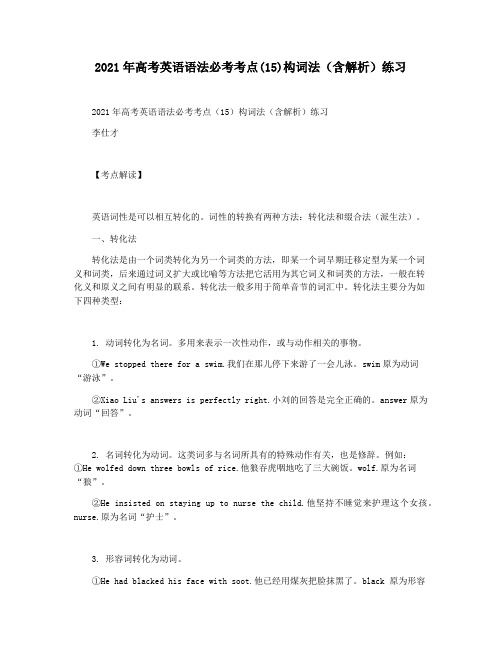
2021年高考英语语法必考考点(15)构词法(含解析)练习2021年高考英语语法必考考点(15)构词法(含解析)练习李仕才【考点解读】英语词性是可以相互转化的。
词性的转换有两种方法:转化法和缀合法(派生法)。
一、转化法转化法是由一个词类转化为另一个词类的方法,即某一个词早期迁移定型为某一个词义和词类,后来通过词义扩大或比喻等方法把它活用为其它词义和词类的方法,一般在转化义和原义之间有明显的联系。
转化法一般多用于简单音节的词汇中。
转化法主要分为如下四种类型:1. 动词转化为名词。
多用来表示一次性动作,或与动作相关的事物。
①We stopped there for a swim.我们在那儿停下来游了一会儿泳。
swim原为动词“游泳”。
②Xiao Liu's answers is perfectly right.小刘的回答是完全正确的。
answer原为动词“回答”。
2. 名词转化为动词。
这类词多与名词所具有的特殊动作有关,也是修辞。
例如:①He wolfed down three bowls of rice.他狼吞虎咽地吃了三大碗饭。
wolf.原为名词“狼”。
②He insisted on staying up to nurse the child.他坚持不睡觉来护理这个女孩。
nurse.原为名词“护士”。
3. 形容词转化为动词。
①He had blacked his face with soot.他已经用煤灰把脸抹黑了。
black 原为形容1 / 16词“黑色的”。
②My father is emptying a box of rubbish into a rubbish-cart.我爸爸正将垃圾倒入垃圾车。
empty原为形容词“空的”。
4. 形容词转化为名词。
即用性质来指代这种性质的事物。
例如:①My mother likes red.我妈妈喜欢红色(的)。
red原为形容词“红色的”。
②The Chinese are working-hard and brave people.人勤劳而勇敢。
01 构词法要点呈现与讲解-备战2023年中考英语一轮复习语法知识+语篇能力双清(通用版)

后缀
例词
useless无用的;careless粗心的;meaningless无 less
意义的
friendly友好的;deadly致命的;weekly每星期 ly
的
dangerous危险的;glorious光荣的;famous著 ous/ious
名的
ward downward向下的;backward向后的
newborn新生的
构成方式
例词
副词+现 hardworking勤劳的;farreaching意义深远 在分词 的
名词+现 peaceloving热爱和平的;epochmaking划时 在分词 代的
名词+过 stateowned国有的;heartfelt由衷的; 去分词 radioequipped装备有无线电的
在……下,次于, subway地(下)道,地铁;
sub
低于
submarine潜水艇Fra bibliotekinter
相互,之间
international国际的;interact 相互作用
前缀
含义
例词
semi
半 semifinal半决赛;semicircle半圆
multi kilo centi
multinational多国的;multi多,多种
构成方式
例词
形容词+名 kindhearted心肠好的;coldblooded冷血的;
词+ed
nobleminded高尚的
形容词+现 goodlooking好看的;easygoing脾气随和的;
在分词
finesounding动听的
形容词+过 readymade现成的;highborn出身高贵的;
高中英语构词法讲解

高中英语构词法讲解高中英语构词法讲解(一):转化法(conversion)在英语中,一个单词由一种词性转化为另一种或几种词性而词形不变的方法叫做转化法。
1. 动词转化为名词Let me have a try. 让我试试。
They are only allowed to sell soft drinks at school.在学校里只准许他们出售不含酒精的饮料。
2. 名词转化为动词He shouldered his way through the crowd.他用肩膀推开人群前进。
The smell from the kitchen made his mouth water.从厨房传来的气味使他流口水。
3. 形容词转化为动词We will try our best to better our living conditions.我们要尽力改善我们的生活状况。
They tried to perfect the working conditions.他们努力改善工作条件。
4. 形容词转化为名词He didnt know the difference between right and wrong.他不辨是非。
The old in our village are living a happy life.我们村的老年人过着幸福的生活。
5. 形容词转化为副词How long have you lived there?你在那儿住多久了?6. 个别词在一定场合中可转化为名词Warm clothes are a must in the mountains.穿暖和的衣服到山区去是必须的。
Life is full of ups and downs.人生有得意时也有失意时。
His argument contains too many ifs and buts.他的辩论中含有太多的如果和但是。
高中英语构词法讲解(二):合成法(composition)由两个或两个以上的单词连在一起合成一个新词,这种构词法叫做合成法,合成的词叫做合成词(compounds)。
构词法(转换法、合成法、派生法)-定义和实例
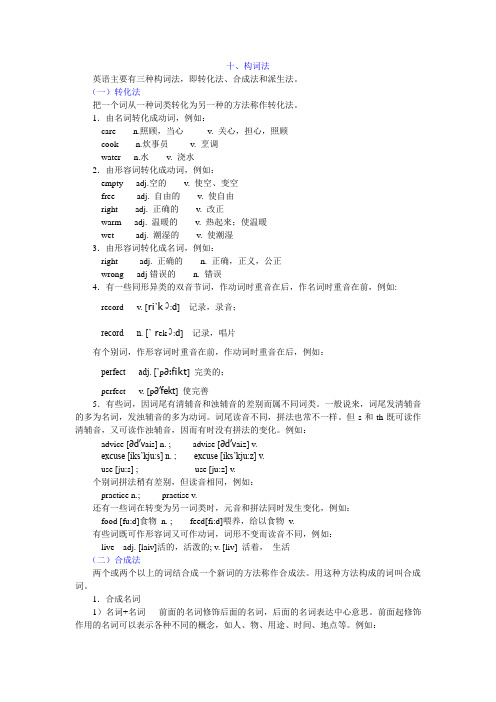
十、构词法英语主要有三种构词法,即转化法、合成法和派生法。
(一)转化法把一个词从一种词类转化为另一种的方法称作转化法。
1.由名词转化成动词,例如:care n.照顾,当心------ v. 关心,担心,照顾cook n.炊事员------v. 烹调water n.水------v. 浇水2.由形容词转化成动词,例如:empty adj.空的------v. 使空、变空free adj. 自由的------v. 使自由right adj. 正确的------v. 改正warm adj. 温暖的------v. 热起来;使温暖wet adj. 潮湿的------v. 使潮湿3.由形容词转化成名词,例如:right adj. 正确的------n. 正确,正义,公正wrong adj错误的------n. 错误4.有一些同形异类的双音节词,作动词时重音在后,作名词时重音在前,例如:record v. [ri’k C:d] 记录,录音;record n. [’ r ek C:d] 记录,唱片有个别词,作形容词时重音在前,作动词时重音在后,例如:perfect adj. [’p∂:f ikt] 完美的;perfect v. [p∂’fekt] 使完善5.有些词,因词尾有清辅音和浊辅音的差别而属不同词类。
一般说来,词尾发清辅音的多为名词,发浊辅音的多为动词。
词尾读音不同,拼法也常不一样。
但s和th既可读作清辅音,又可读作浊辅音,因而有时没有拼法的变化。
例如:advice [∂d’v ais] n. ; advise [∂d’v aiz] v.excuse [iks’kju:s] n. ; excuse [iks’kju:z] v.use [ju:s] ; use [ju:z] v.个别词拼法稍有差别,但读音相同,例如:practice n.; practise v.还有一些词在转变为另一词类时,元音和拼法同时发生变化,例如:food [fu:d]食物n. ; feed[fi:d]喂养,给以食物v.有些词既可作形容词又可作动词,词形不变而读音不同,例如:live adj. [laiv]活的,活泼的; v. [liv] 活着,生活(二)合成法两个或两个以上的词结合成一个新词的方法称作合成法。
- 1、下载文档前请自行甄别文档内容的完整性,平台不提供额外的编辑、内容补充、找答案等附加服务。
- 2、"仅部分预览"的文档,不可在线预览部分如存在完整性等问题,可反馈申请退款(可完整预览的文档不适用该条件!)。
- 3、如文档侵犯您的权益,请联系客服反馈,我们会尽快为您处理(人工客服工作时间:9:00-18:30)。
examination--exam
另外还有许多缩写词是由各个单词的首字母组 成. CD ( compact disk)
CCTV( China Central Television)
NBA (National Basketball Association)
UFO( unidentified flying object)
black+ board= blackboard (形容词+名词) 复合形容词 warm + heart + ed = warmhearted 热心肠的
good + looking = good-looking 相貌好看的
world +wide= worldwide 世界性的 hard+ working=hard-working 努力工作的 world+ famous=world-famous 闻名于世的
复合动词:
over + come = overcome克服
复合代词:
(副词+动词)
everyone, somebody, anything, nobody
( 不定代词+名词) 复合副词: down+ stairs = downstairs在楼下( 形容词+名词) whole+ heartedly =wholeheartedly 全神贯注地 (副词+副词)
3. 转化 : 是指有一种词类转化为另一种词类。 单词转化后的意义往往与之前的意义联 系密切. water n. 水 ------ water vt. 浇水 常见的转化形式两种:
动词 --- 名词
名词 --- 动词 形容词---动词
动词----名词 stop v. 停止 --- n.车站 love v. 爱 --- n. 爱 watch v. 观看 --- n. 手表 look v. 看 ----have a look n. 看 walk v. 散步,走---take a walk n.散步 love v. 爱--- your love n. 爱
trans-(横过,通过,超越,进入)
transplant,
transatlantic (横渡大西洋的
(G)表示两个,双边的前缀: bi- bicolor ( 双色的), bicycle (H)表示相互, 交互, 在一起的前缀 inter—interview, international, internet (I)表示又,再,重新的前缀 re—review, return, rewrite (J)表示远的前缀 tele– telephone, television
amuse ---------- amusement
mis- 错误的
前缀一般只引起意思上的变化而不造 成词类的变化,只有少数能引起词类 的变化。
understand
v. 理解 read-----------misread 理解 误解 dis- 不 agree
→ misunderstand → v. 误解
(C).表示向背的前缀: pro-(亲,支持) pro-Chinese, pro-American anti-(阻止,抗) antiwar, anti-Japanese war
(D).表示程度、大小的前缀 supersuperstar,supermarket, superman, superpower overoverhead, overeat, overuse miniminibus, miniskirt, mini-car underunderground, underestimate semi-(半,部分) semicircle, semiskilled,
表达
wrong
S
subtitle
副标题
subway
地铁
总是
always graduation sideways n graduate
mistaken n mistake
误解
underway
地下通道
underground
地下的
misunderstand
root
understand
大学生
undergraduate
UN( United Nations) ID( identification) USA( United States of America)
careful 1. If he had been __________(care), he would not have fallen from the ladder. doubtful 2. It is ________(doubt) whether he will come. 3. My house is in a very quiet street, so I can disturbance work here without any _____________(disturb). simultaneously 4. Thunder and lightning happen ______________ (simultaneous). 5. The weather was good except for an occasional _________ (occasion) shower. silently 6. Seeing that he was working ____________ (silence) in the room, I left on tiptoe at once.
转化法(Conversion)
taste
n. 味道
It has a good taste.
v.尝起来 It tastes very good.
record
Liu Xiang Broke the 100m n.记录 Hurdles World Record . v. 记录 He lies to record something while reading a book.
英语构词法
合Hale Waihona Puke 词pain-killerCompound
+
=
sleep-walk
+
=
sleep-walker
color- blind
+
=
英语构词法种类
英语构词法主要有三种: 合成、派生与转化。
另外缩写和简写也是构词法的一种。
1. 合成 :
有两个或更多的词合成一个词。
复合名词
class + room = classroom (名词+名词)
→ disagree v.同意 → v.不同意
后缀一般只引起词性上的变化而不 造成意思的变化。
care v. 照料 --- careful adj. 细心的 work v. 工作 --- worker n. 工人
常见的前缀
(A)表示否定的前缀:
un-unfair,unhappy non-nonsmoker (常用在n. adj. adv. 前) in-inactive (常用在adj.后) dis-disagree, disappear im-impolite, impossible (用在b,p,m 开头的词前) (B).表示错误或失当的前缀: mis-misunderstand, misdirect(误导) dis- agree → disagree
-ed surprised, balanced, talented, amused -ing interesting, outstanding, amusing
4.动词变形容词
-al
traditional, international, natural
5. 名词、形容词变动词:
-ify
beautify, simplify -ize realize -en quicken, widen, lengthen, sharpen (使变快)(加宽)(加长)(使变尖
原来把某些词合在一起又是另一个词, 英语单词不过这样嘛,看来我只要 稍微留意一下那些有关联的的词,注意 观察一下,就会认识更多哦! E g: cowboy, blackboard, post office, bus stop等。
2. 派生 :
是通过在词根上加前缀或者后 缀构成一个新词。
Happy---------------------unhappy
名词 ---- 动词
hand n. 手 seat n. 座位 --- vt. 上交 --vt. 坐
nurse n. 护士
oil n. 油 time n. 时间 ---
-----
vt. 护理
vt. 上油
vt. 定时,测时
show n. 展览,展示—vt. 表演,演出
形容词----动词 slow( adj. 慢的)---slow ( v. 放慢) open (adj. 开着的)—open( v.开)
root
4. 缩写和简写 : 缩写和简写(也被称为截断法或缩 短法)主要采取: “截头”, “去尾” 或者 “既截头又去尾”的方法生成 telephone---phone 新词.
airplane—plane laboratory-lab mathematics--math advertisement—ad
independent
独立的
root
depend
adj O
dependable possible education n
残疾的
incorrect
O
不可能的
impossible
disable n disability possibility expression
correct
S
n
